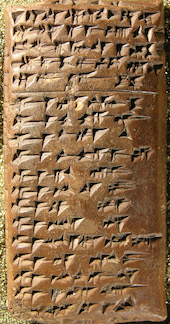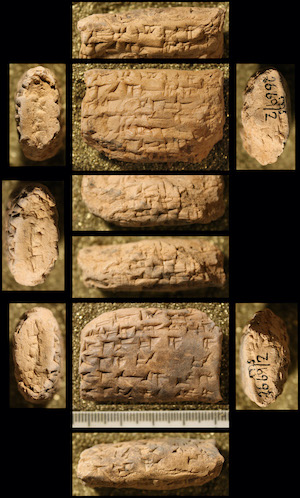You are seeing an unstyled version of this site. If this is because you are using an older web browser, we recommend that you upgrade to a modern, standards-compliant browser such as FireFox [http://www.getfirefox.com/], which is available free of charge for Windows, Mac and Linux.
Neo-Assyrian Archival Texts from Ma'allanate

Obverse of MS 3188, a sealed tablet recording the sale of a slave woman during the reign of Ashurbanipal (1–VII–651 BC). Photo Credit: CDLI [https://cdli.ucla.edu/dl/photo/P342654.jpg]
All the 49 cuneiform and 24 Aramaic documents identified as coming from the ancient town Maʿallanate were illicitly excavated and acquired on the antiquities market. 41 of the cuneiform documents and all the Aramaic documents were bought by the Musées Royaux d'Art et d'Histoire de Bruxelles (MRAH) in 1972. These cuneiform documents were published as ACP (Archives d'un Centre Provincial) 1–41 by D. Homès-Fredericq and P. Garelli, Maʿallanate: Archives d'un centre provincial de l'empire assyrien (Akkadica Supplementum 13), Brussels, 2018, and the Aramaic documents (ACP 42–65) were published by E. Lipiński, Studies in Aramaic Inscriptions and Onomastics III: Ma'lānā (Orientalia Lovaniensia Analecta 200), Leuven, 2010.
Of the other 8 currently known cuneiform documents, 5 have ended up in the Bible Lands Museum in Jerusalem (one published by A.K. Grayson in O.W. Muscarella (ed.) Ladders to Heaven. Art Treasures from Lands of the Bible. Toronto 1981: 126–127 no. 84; three published by A.K. Grayson in "Three Neo-Assyrian documents," in D. Charpin and F. Joànnes (eds.), Marchands, diplomates et empereurs, Paris, 1991: 357–362, and one published by K. Radner in M. Jursa and K. Radner, "Keilschrifttexte aus Jerusalem," [https://epub.ub.uni-muenchen.de/25085/] Archiv für Orientforschung 42 (1995-96): 89-108, 100-102); two are now in the Schøyen Collection in Oslo (both published by K. Radner, "Neo-Assyrian Tablets," in A.R. George, Thomas Hertel, Jaume Llop-Raduà, Karen Radner and Wilfred H. van Soldt, Assyrian Archival Texts in the Schøyen Collection and Other Documents from North Mesopotamia and Syria (Cornell University Studies in Assyriology and Sumerology 34), Bethesda, 2017: 77–126 nos. 47 and 50); one fragment of a tablet is in the Archaeological Museum of Kayseri (now joined to a fragment in the MRAH and published as ACP 20); and one tablet is in the Siegfried H. Horn Museum of Andrews University, Berrien Springs, Michigan (ACP 71). A preliminary edition of the Andrews University tablet has been published by Homès-Fredericq and Garelli 2018: 113-114 and a photograph of the tablet is available on the CDLI platform (CDLI number: P249670 [https://cdli.ucla.edu/p249670]).
References in the documents to other towns in the region, such as Asihu and Qaštu, indicates that Maʿallanate was not an isolated urban community. Its site is still unidentified but two proposals for its approximate location have been made. The first places it in the upper Balikh valley, northern Syria on the grounds that Maʿallanate is identical with Mallanum (written ma-al-la-nim.ki), a place attested a millennium earlier and locatable in this area (D. Charpin, Nouvelles Assyriologiques Brèves et Utilitaires 1987/38). The second proposal places the site further east, on the Habur river between Tell Halaf/Guzana and Al-Hasakah, by identifying Asihu with an earlier Ašihum in the Guzana area (Lipiński 2010: 8). Recent opinion favours the first location because there seem to have been two earlier places called Ašihum, and one of these can, in fact, be located in the upper Balikh valley, i.e. in the same area as Mallanum (Homès-Fredericq and Garelli 2018: 28 with further literature).
The nature of the documents from Maʿallanate identified so far suggests that they represent private archives rather than an archive of an institution (Homès-Fredericq and Garelli 2018: 40). The documents are concerned with the affairs of three officials of the Assyrian crown: Handî (Handiya in Babylonian, Haddî in Aramaic), Harranaya, and Ser-nuri (Šehr-nuri in Aramaic). Handî and Harranaya were father and son; Handî held the title "palace prefect" (šaknu ša ēkalli) and was active 700–665, and Harranaya is attested with the title "prefect" (šaknu) and was active 661–644. Their relationship with Ser-nuri, active 652–622, is unclear. Ser-nuri could be the same person as Sîn-nammir (ACP 36, ACP 68 [/atae/mallanate/P522885,P522917]), in which case he would be the son of Harranaya, but this idea has not been widely accepted. His professional title is not mentioned in the documents (ACP 32–39, 55–64) but his affairs took him to both Guzana and Nineveh, and he was active, presumably as a soldier, in an "enemy land" (ACP 68).

Obverse of MS 2669/2, a legal transaction of Šulmu-Bel-Arrapha drawn up during the reign of Sennacherib (700 BC). Photo Credit: CDLI [https://cdli.ucla.edu/dl/photo/P251707.jpg]
Most of the cuneiform documents related to Handî (ACP 1–16, 18) are contracts recording his purchase of slaves and agricultural land. Interestingly, these investments seem to have been made for his personal gain: no other Assyrian official or the king is mentioned. The cuneiform documents related to Harranaya (ACP 17, 19–31) also include land-sale contracts, but in contrast to Handî's dossier there are many more debt notes and documents recording quotidian transactions. Indeed, the Andrews University tablet (ACP 71 [/atae/mallanate/P249670]) seems to record the repayment of one of Harranaya's debts by one of his sons, Harmaku.
In addition to the presence of Assyrian officials, which is reflected in the cuneiform documents, most of which are formatted and phrased according to Assyrian official usage, there are three documents from the period of Handî's activities (ACP 9, 15, 18 [/atae/mallanate/P522858,P522864,P522867]) that are written in Babylonian script and dialect. These documents may reflect the presence at Maʿallanate of deportees from Babylonia. In addition, the appearance of two individuals bearing names that contain the element Yahweh (Barak-Yau in ACP 16 [/atae/mallanate/P522865], dated 665, and Azri-Yau in ACP 17 [/atae/mallanate/P522866], dated 644) indicates that Israelites were also present in the area, presumably as a result of earlier Assyrian deportations from the west (Homès-Fredericq and Garelli 2018: 35–36). Finally, the Aramaic documents as well as the onomasticon of the individuals named in all the documents reflects the native Aramaic-speaking population of the upper Balikh valley. Aramaic seems to have been the script of choice for business matters that were not the direct responsibility of the imperial administrators (Homès-Fredericq and Garelli 2018: 37).
The aim of the Ma'allanate sub-project of Archival Texts of the Assyrian Empire (ATAE) [/atae/index.html] Project is to make the published Neo-Assyrian and Neo-Babylonian archival texts from this ancient city available online for free in a fully searchable and richly annotated (lemmatized) format, as well as to widely disseminate, facilitate, and promote the active use of these important cuneiform sources in academia and beyond. ATAE/Ma'allanate presently includes seventy-three documents written in Neo-Assyrian Akkadian, Neo-Babylonian Akkadian, and Aramaic. In addition to the primary places of publication mentioned above, further editions and studies of several of the documents can be found in the following works:
- F.M. Fales, "A payment in reeds," [https://web.archive.org/web/20150814225514/http://www.helsinki.fi/science/saa/4.1%2008%20Fales%20Odds&Ends.pdf] State Archives of Assyria Bulletin 4 (1990): 73-75;
- R. Jas, Neo-Assyrian Judicial Procedures (State Archives of Assyria Studies 5), Helsinki, 1996: 22–24 no. 11;
- F. Joannès, "Paṭāru «acheter» dans un texte de Maʻallānāte," in V. Boschloos, B. Overlaet, I.M. Swinnen, V. Van der Stede (eds), Travels through the Orient and the Mediterranean World: Essays presented to Eric Gubel (Orientalia Lovaniesia Analecta 302; Greater Mesopotamia Studies 3); Keuven, 2021: 173-184;
- E. Lipinski, Studies in Aramaic Inscriptions and Onomastics II (Orientalia Lovaniensia Analecta 57), Leuven, 1994: pp. 217–33; and
- J.N. Postgate, "Assyrian texts and fragments," [https://www.jstor.org/stable/4199949] Iraq 35 (1973): 13–36.
Click here [/atae/mallanate/pager] to browse the Ma'allanate corpus.
ATAE is a key component of the Archival Texts of the Middle East in Antiquity (ATMEA) sub-project of the LMU-Munich-based Munich Open-access Cuneiform Corpus Initiative [https://www.en.ag.geschichte.uni-muenchen.de/research/mocci/index.html] (MOCCI; directed by Karen Radner and Jamie Novotny). Funding for the ATAE corpus project has been provided by LMU Munich and the Alexander von Humboldt Foundation (through the establishment of the Alexander von Humboldt Chair for Ancient History of the Near and Middle East).
For further details, see the "About the project" [/atae/abouttheproject/index.html] page.

Mary Frazer
Mary Frazer, 'Neo-Assyrian Archival Texts from Ma'allanate', Neo-Assyrian Archival Texts from Ma'allanate, The ATAE/Ma'allanate Project, a sub-project of MOCCI, 2023 [http://oracc.org/atae/mallanate/]